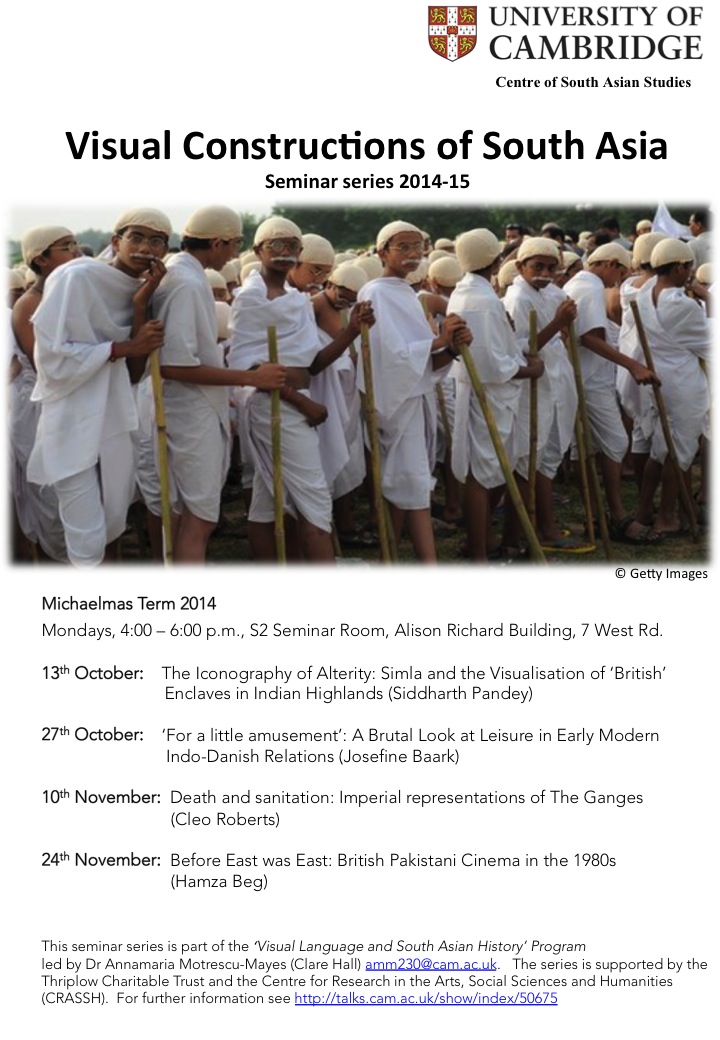'The Iconography of Alterity: Simla and the Visualisation of ‘British’ Enclaves in Indian Highlands' (Siddharth Pandey)
Duration: 1 hour 37 mins
Share this media item:
Embed this media item:
Embed this media item:
About this item

| Description: |
The first seminar in the ‘Visual Constructions of South Asia’ series. The series is being supported by the Cambridge-India partnership (http://www.cambridge-india.org) and by the Thriplow Charitable Trust. It acts as a sequel to the ‘Visual Anthropology and Contemporary South Asian History’ Conference (http://www.crassh.cam.ac.uk/events/25024) and will comprise 12 two-hour seminars offered fortnightly, i.e. four seminars per term, during the 2014-15 academic year.
This seminar series is part of the the ‘Visual Language and South Asian History’ Programme led by Dr Annamaria Motrescu-Mayes. The aims of this series are twofold. First, to introduce Cambridge (under-, postgraduate) students, academic staff, researchers at different career stages and visiting scholars to the ways in which visual research methods support the development of new perspectives on South Asian history and culture. Second, to align the University of Cambridge prospectus to contemporary developments and programs in visual culture and South Asian studies – programmes already offered by all other major international universities. Each seminar takes place in S2 seminar room, Alison Richard Building, 7 West Road, Cambridge, between 4:00 – 6:00p.m. The seminar dates in Michaelmas term are 13th and 27th October, and 10th and 24th November 2014. The seminar dates in Lent term are 19th January, 2nd and 16thFebruary, and 2nd March 2015. The seminar dates in Easter term are 27th April, 11th and 25th May, and 8th June 2015. |
|---|
| Created: | 2014-11-11 22:38 |
|---|---|
| Collection: | 'Visual Constructions of South Asia' seminar series (Michaelmas 2014) |
| Publisher: | University of Cambridge |
| Copyright: | Dr A.M. Motrescu-Mayes |
| Language: | eng (English) |
| Distribution: |
World
|
| Keywords: | Indian hill stations; Simla; British India; visual culture; |
| Explicit content: | No |
| Abstract: | This seminar aims to understand the politics of visualisation in the setting up of Indian hill stations. Nineteenth-century India witnessed the growth of a new urban entity across its length and breadth, that of the ‘hill station’. Serving as an “other” to the heat and dust-ridden cities such as Delhi and Calcutta lying in the flat plains, the hill station was developed by the colonizers in the nostalgic image of their home lying far away in the British Isles. This presentation looks into the visual documentation of such a lifestyle through a variety of media: sketches, lithographs, architecture, photographs, and postcards. Keeping Simla – the summer capital of British India from 1864 to 1947, and the most famous hill station – as its focus, the seminar hopes to chart a history of perception of the hill station’s evolution through a detailed exposition of material archives covering a period of around two centuries. It ends with a commentary on the contemporary state of Simla’s “visualisation”.
|
|---|---|

